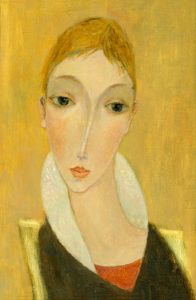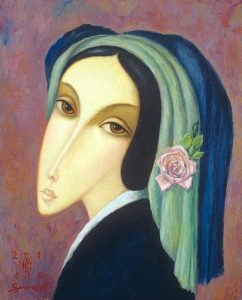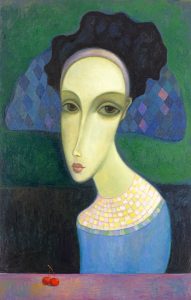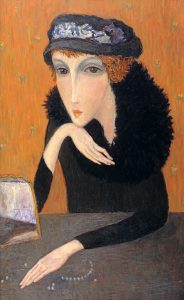< Artists
Sergey Smirnov
There is Something of the Saints in the art of Sergey Smirnov.
Sergey Smirnov’s subjects look out from the picture plane with serene and liquid eyes. Their features are delicate, pale, and fine. They seem pensive, or perhaps they simply remain aloof from the comings and goings of the world around them. In every case, their eyes dominate the canvas of their face. If, indeed, the eyes are the windows to the soul, then the souls Sergey Smirnov reveals are deep and profound, and in their simplicity, reminiscent of the haunting and beautiful images found in old Russian church iconography.
There is something of the saints in Sergey Smirnov’s art; something of the world and its joys and sorrows is in his eloquent and mute figures. To know the steps Smirnov has taken on his journey as an artist is to understand the evolution of his sentiment and style.
Master of the Art of Painting Icons
Sergey Smirnov was born in 1953, in an area of Russia bordering the Pacific Ocean known as the Kamchatka Peninsula. His father was an army officer who moved his family from base to base throughout Russia. In his late teen years, Smirnov and his family settled in Moscow, where he went to work for the Ministry of Agriculture.
In 1979, Sergey Smirnov began to take classes at the Moscow City Art College. He graduated from the art college in 1983 as class valedictorian, with a master’s degree in art. His remarkable skill in church and cathedral renovation, led to a prestigious position as a restorer of aging and antique church icons and frescoes. Two years later, he began painting icons–a long-standing tradition among Russia’s artists–and his work now graces several major churches throughout the country.
Free to Paint
Starting in 1991, Sergey Smirnov designed and developed logos and graphics for a wide variety of Russian corporations, winning countless national and international awards for his work. He also served as chief editor for the Advertising and Image Creation Corporation of the Russian government’s International Trade Corporation. But in 1994 this spirit moved him to devote himself entirely to painting.
The Old Argument for Oil on Canvas
Sergey Smirnov set up his atelier, choosing oil on canvas as his preferred medium. Oil paint is more “natural” than acrylic in tone and saturation. Oils have a translucent quality that allows the artist to achieve subtler variations in hue through mixing and layering. Also, oil paint takes much to dry than acrylic paint, and there is greater malleability with the medium. The layers and the colors can be blended and manipulated over a much longer period of time.
Painting “Persuna” or Masks
Sergey Smirnov’s works have a subtle, jewel-like quality in both line and tone. There is a precision to each silhouette and to every feature of the faces he depicts that is reminiscent of the sharpness of the facets of a cut gemstone. The colors Smirnov uses bring to mind semiprecious stones: carnelian reds, moss agate greens, the browns of smoky quartz, the yellows of topaz and citrine, the purples of amethyst and tanzanite. The backgrounds Smirnov selects for his portraits are rich and textured, rippling with minute variations in hue and saturation.
In looking at Sergey Smirnov’s art, one can easily appreciate that Smirnov ranks Gustav Klimt, the Austrian painter whose images were a cornerstone of the art nouveau movement, as an important influence. He also cites Modigliani and Rembrandt as major influences, as well as Andrei Rublev and Pheophan Grek, who were celebrated masters of Slavic icon painting. Smirnov’s style has echoes of his favorite period of Russian art, known as “parsuna,” which bridged the worlds of religious and personal portraiture, as Russian painters began adopting the portrait painting styles of Western European salons. “Parsuna,” which is derived from the Latin persona, means mask, and the hybrid imagery, first used in the 17th century, remains in play to this day in the art of Sergey Smirnov.
A Modern Day Russian Icon
In 1997, Sergey Smirnov was honored as only the third living artist to have a personal exhibit in the Kremlin’s Manezh, which ranks as one of the most prestigious art galleries in the world. For three weeks, people from across Russia lined up at the gallery to catch a glimpse of Smirnov’s haunting, elegant art. In the same year, Smirnov exhibited at the Orlean House in London, dazzling both critics and the public with his work. Smirnov has been avidly collected throughout the world, and his art is included in several noteworthy Russian collections, including those of former Russian president Boris Yeltsin, former prime minister Victor Chernomirdin, leading business leader and presidential adviser Boris Berezovsky, Minister of Transportation Sergey Frank, and Minister of Defense Marshall Shaposhnicov.
Sergey Smirnov passed away November 8, 2006 while in the United States for an exhibition.



















